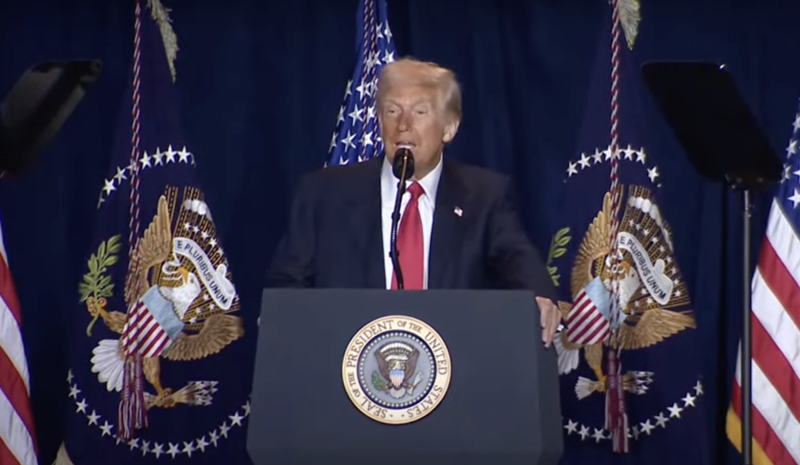President Donald Trump took another step forward on his plan to put reciprocal tariffs on U.S. trading partners Thursday by signing a memo directing his staff come up with solutions in 180 days.
“On Trade, I have decided, for purposes of Fairness, that I will charge a RECIPROCAL Tariff meaning, whatever Countries charge the United States of America, we will charge them – No more, no less!” Trump wrote Thursday afternoon on Truth Social.
From the Oval Office, Trump said consumers won’t necessarily face higher prices as a result of the reciprocal tariffs.
“I’ll tell you what will go up: Jobs,” he said. “The jobs will go up tremendously. We’re going to have great jobs. Jobs for everybody.”
The president also said that ultimately, he expects prices to go down. He said there could be some short-term “disturbance” but expects prices to decrease.
“Prices could go up somewhat short-term,” Trump said. “But prices will also go down.”
At another point, he said: “Nobody really knows what’s going to happen.”
On Truth Social, the president said he will consider other countries use of value-added taxes or VAT, a consumption tax assessed on the value added in each production stage of a good or service. Such taxes are common in European countries.
“For purposes of this United States Policy, we will consider Countries that use the VAT System, which is far more punitive than a Tariff, to be similar to that of a Tariff. Sending merchandise, product, or anything by any other name through another Country, for purposes of unfairly harming America, will not be accepted,” Trump wrote.
“In addition, we will make provision for subsidies provided by Countries in order to take Economic advantage of the United States. Likewise, provisions will be made for Nonmonetary Tariffs and Trade Barriers that some Countries charge in order to keep our product out of their domain or, if they do not even let U.S. businesses operate,” the president continued. “We are able to accurately determine the cost of these Nonmonetary Trade Barriers. It is fair to all, no other Country can complain and, in some cases, if a Country feels that the United States would be getting too high a Tariff, all they have to do is reduce or terminate their Tariff against us. There are no Tariffs if you manufacture or build your product in the United States.”
The memo orders Commerce Secretary Howard Lutnick and Trade Representative nominee Jamieson Greer to evaluate custom country-by-country remedies to U.S. trade deficits. Office of Management and Budget boss Russell Vought would then submit a report within 180 days to assess the fiscal impact of the tariffs.
The order came short of imposing the tariffs immediately. Trump has forestalled all but one of his tariff orders so far. He agreed to pause 25% tariffs on Mexico and Canada after leaders of those countries promised to strengthen border security to stop fentanyl from entering the U.S., a decades-long problem that some view as intractable. Trump did go forward with a 10% tariff on imports from China. China responded with limited tariffs on U.S. imports and filed a complaint with the World Trade Organization.
Trump also moved to impose 25% tariffs on steel and aluminum imports. Those could start March 1.
Trump said Thursday that his plan was to level the playing field.
“For many years, the U.S. has been treated unfairly by other Countries, both friend and foe. This System will immediately bring Fairness and Prosperity back into the previously complex and unfair System of Trade,” Trump wrote. “America has helped many Countries throughout the years, at great financial cost. It is now time that these Countries remember this, and treat us fairly – A LEVEL PLAYING FIELD FOR AMERICAN WORKERS.”
Trump touted tariffs throughout his campaign and during his inauguration said tariff revenue would make the U.S. “rich as hell.” He also said that tariff revenue would lower the tax burden on American taxpayers.
Most economists have questioned Trump’s tariff plans.
Last week, S&P Global, a credit-rating agency, reported the potential effects of Trump’s tariffs were “overwhelmingly negative.” S&P analysts said the tariffs could slow gross domestic product growth, boost unemployment and inflation. It noted that “the effects on the U.S. are smaller than for trading partners.” Gross Domestic Product, or GDP, is a measure of economic output. S&P noted the uncertainty around Trump’s tariff plans creates problems for businesses and U.S. families.
Full memo:
02/13/25
MEMORANDUM FOR THE SECRETARY OF THE TREASURY
THE SECRETARY OF COMMERCE
THE SECRETARY OF HOMELAND SECURITY
THE DIRECTOR OF THE OFFICE OF MANAGEMENT AND BUDGET
THE UNITED STATES TRADE REPRESENTATIVE
THE ASSISTANT TO THE PRESIDENT FOR ECONOMIC POLICY
THE SENIOR COUNSELOR TO THE PRESIDENT FOR TRADE
AND MANUFACTURING
SUBJECT: Reciprocal Trade and Tariffs
By the authority vested in me as President by the Constitution and the laws of the United States of America, it is hereby ordered:
Section 1. Background. The United States has one of the most open economies and has among the lowest average weighted tariff rates in the world. The United States imposes fewer barriers to imports than other major world economies, including those with similar political and economic systems. For many years, the United States has been treated unfairly by trading partners, both friend and foe. This lack of reciprocity is one source of our country’s large and persistent annual trade deficit in goods — closed markets abroad reduce United States exports and open markets at home result in significant imports.
Our workers and industries bear the brunt of unfair practices and limited access to foreign markets. As noted in the Presidential Memorandum of January 20, 2025 (America First Trade Policy Memorandum), this situation is untenable. The trade deficit of the United States threatens our economic and national security, has hollowed out our industrial base, has reduced our overall national competitiveness, and has made our Nation dependent on other countries to meet our key security needs. By making trade more reciprocal and balanced, we can reduce the trade deficit; grow the United States economy; and improve our trade relationships with trading partners to the benefit of American workers, manufacturers, farmers, ranchers, entrepreneurs, and businesses.
Sec. 2. Policy. It is the policy of the United States to reduce our large and persistent annual trade deficit in goods and to address other unfair and unbalanced aspects of our trade with foreign trading partners. In pursuit of this policy, I will introduce the “Fair and Reciprocal Plan”(Plan). Under the Plan, my Administration will work strenuously to counter non-reciprocal trading arrangements with trading partners by determining the equivalent of a reciprocal tariff with respect to each foreign trading partner. This approach will be of comprehensive scope, examining non-reciprocal trade relationships with all United States trading partners, including any:
(a) tariffs imposed on United States products;
(b) unfair, discriminatory, or extraterritorial taxes imposed by our trading partners on United States businesses, workers, and consumers, including a value-added tax;
(c) costs to United States businesses, workers, and consumers arising from nontariff barriers or measures and unfair or harmful acts, policies, or practices, including subsidies, and burdensome regulatory requirements on United States businesses operating in other countries;
(d) policies and practices that cause exchange rates to deviate from their market value, to the detriment of Americans; wage suppression; and other mercantilist policies that make United States businesses and workers less competitive; and
(e) any other practice that, in the judgment of the United States Trade Representative, in consultation with the Secretary of the Treasury, the Secretary of Commerce, and the Senior Counselor to the President for Trade and Manufacturing, imposes any unfair limitation on market access or any structural impediment to fair competition with the market economy of the United States.
The Plan shall ensure comprehensive fairness and balance across the international trading system by factoring in losses as a result of measures that disadvantage the United States as applied, regardless of what they are called or whether they are written or unwritten.
Sec. 3. Taking Action. (a) After the submission of the specified agency reports due under the America First Trade Policy Memorandum, the Secretary of Commerce and the United States Trade Representative, in consultation with the Secretary of the Treasury, the Secretary of Homeland Security, the Assistant to the President for Economic Policy, the Senior Counselor to the President for Trade and Manufacturing, and the heads of such other executive departments and agencies as the Secretary of Commerce and the United States Trade Representative deem relevant, shall initiate, pursuant to their respective legal authorities, all necessary actions to investigate the harm to the United States from any non-reciprocal trade arrangements adopted by any trading partners. Upon completion of such necessary actions, they shall submit to me a report detailing proposed remedies in pursuit of reciprocal trade relations with each trading partner.
(b) Within 180 days of the date of this memorandum, the Director of the Office of Management and Budget shall assess all fiscal impacts on the Federal Government and the impacts of any information collection requests on the public, and shall deliver an assessment in writing to the President.
Sec. 4. Definitions. For the purposes of this memorandum:
(a) “Value-added tax” means a type of consumption tax that is levied on the incremental increase in value of a good or service at each stage of the supply chain.
(b) “Nontariff barrier” or “measure” means any government-imposed measure or policy or nonmonetary barrier that restricts, prevents, or impedes international trade in goods, including import policies, sanitary and phytosanitary measures, technical barriers to trade, government procurement, export subsidies, lack of intellectual property protection, digital trade barriers, and government-tolerated anticompetitive conduct of state-owned or private firms.
Sec. 5. General Provisions. (a) Nothing in this memorandum shall be construed to impair or otherwise affect:
(i) the authority granted by law to an executive department or agency, or the head thereof; or
(ii) the functions of the Director of the Office of Management and Budget relating to budgetary, administrative, or legislative proposals.
(b) This memorandum shall be implemented consistent with applicable law and subject to the availability of appropriations.
(c) This memorandum is not intended to, and does not, create any right or benefit, substantive or procedural, enforceable at law or in equity by any party against the United States, its departments, agencies, or entities, its officers, employees, or agents, or any other person.
(d) The United States Trade Representative is authorized and directed to publish this memorandum in the Federal Register.






